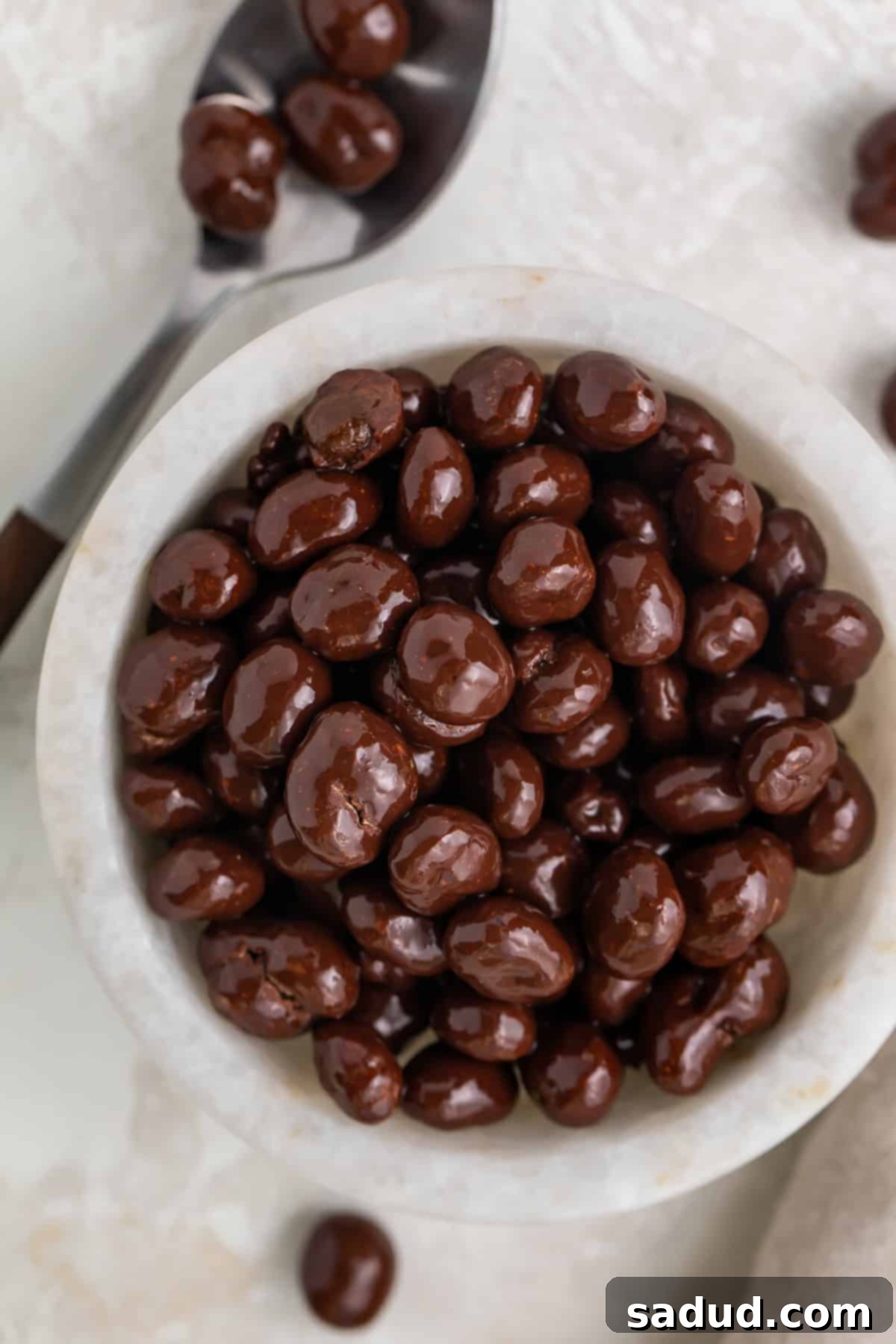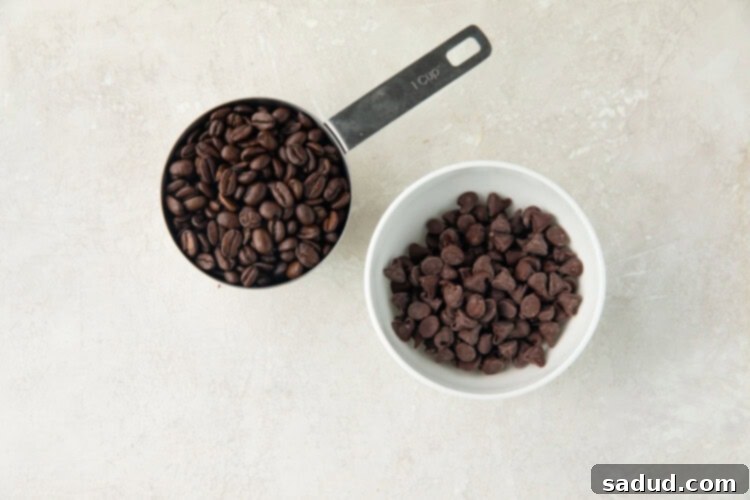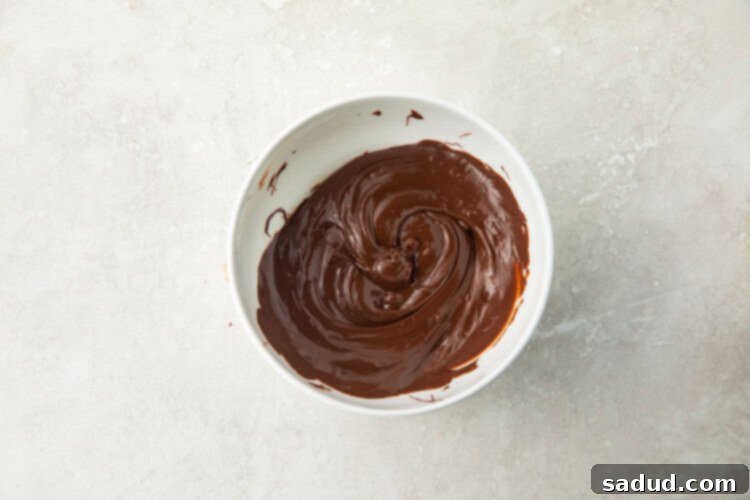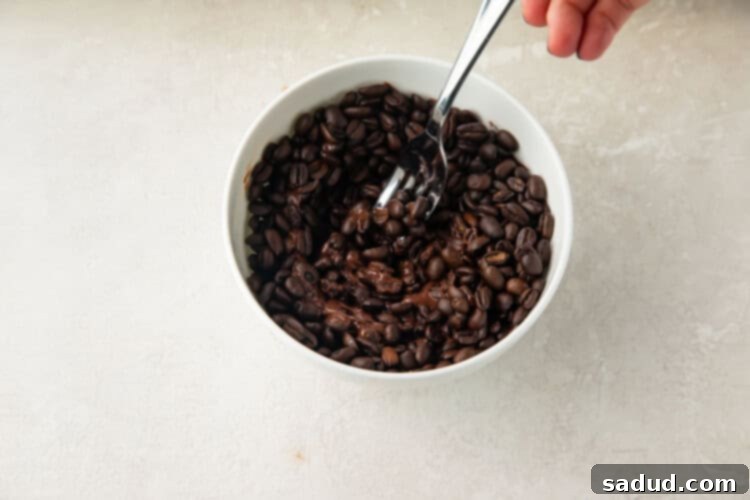Irresistible 2-Ingredient Chocolate Covered Espresso Beans: Your Ultimate Energy Boost & Sweet Treat Recipe
Are you searching for that perfect pick-me-up that’s both deliciously sweet and wonderfully invigorating? Look no further! These homemade chocolate covered espresso beans are the ultimate bite-sized delight, offering a delightful crunch, rich chocolatey flavor, and a welcome kick of caffeine. This incredibly simple recipe requires just two core ingredients and comes together in under 15 minutes, making it an ideal treat for busy schedules or spontaneous cravings. Whether you need a quick energy boost, a delightful after-dinner treat, or a thoughtful homemade gift, these irresistible morsels are sure to become a new favorite in your snack repertoire.
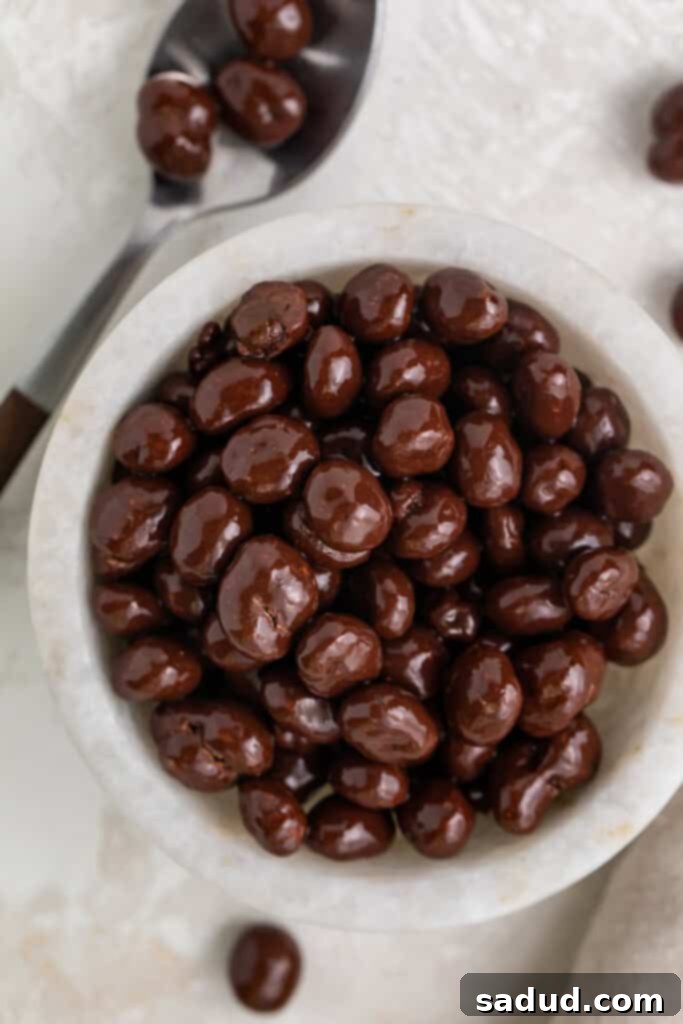
Why You’ll Love This Simple Chocolate Covered Espresso Bean Recipe
This recipe isn’t just easy; it’s a game-changer for anyone who loves coffee and chocolate. Here’s what makes it an absolutely fantastic addition to your snack collection:
- Effortless Simplicity: At its heart, this recipe champions minimalism with only two primary ingredients. Forget about complex shopping lists or tracking down obscure items; everything you need is readily available at virtually any local grocery store. This streamlined approach means less time spent preparing and more time savoring your delicious, homemade creation.
- Instant & Sustained Energy Boost: Thanks to the whole espresso beans, these treats pack a potent caffeine punch, offering a swift and sustained energy lift. While the exact caffeine content can fluctuate based on the type of bean and roast, whole coffee beans generally contain more caffeine than an equivalent amount of brewed coffee. This makes them a perfect alternative to your afternoon espresso or a sugary energy drink, providing focus and vitality. For those sensitive to caffeine, moderation is key, but for many, it’s a welcomed gentle buzz.
- Convenient Storage and Extended Shelf Life: Prepare a batch and keep them readily available for whenever a craving strikes! These delightful morsels can be stored in an airtight container at room temperature for up to one week, maintaining their perfect crunch and flavor. For even longer-lasting freshness, refrigerate them for up to two weeks, or extend their lifespan significantly by freezing them in an airtight, freezer-safe container for up to one month. This makes them ideal for snack prepping or for having a delicious treat on hand for unexpected guests.
- Infinitely Customizable: This recipe serves as a perfect blank canvas for your culinary imagination. From the type of chocolate (dark, milk, white, or flavored) to various optional add-ins and coatings, you can effortlessly tailor these beans to precisely match your personal preferences, dietary needs, or even seasonal themes.
- Lightning-Fast Preparation: In today’s fast-paced world, quick recipes are gold. From start to finish, you can have a fresh batch of these delectable chocolate covered espresso beans ready in less than 15 minutes. It’s quicker than brewing a specialty coffee and infinitely more satisfying than reaching for a store-bought snack.
Key Ingredients for Your Perfect Chocolate Covered Espresso Beans
Creating these delightful chocolate-covered espresso beans requires just two main stars, but selecting the right ones can truly elevate your snack from merely good to absolutely extraordinary, showcasing a depth of flavor.
Espresso Beans – Despite the name, “espresso beans” don’t refer to a distinct type of coffee bean. Rather, it typically describes a dark roast of coffee beans, optimized for the rich, intense flavor often associated with espresso brewing. The fantastic news is that you can use virtually any whole-bean coffee you find at your local grocery store or specialty coffee shop! The most important factor is to select beans whose intrinsic flavor you genuinely enjoy, as their subtle, nutty, or even fruity notes will delightfully shine through the chocolate coating.
- Understanding Roast Levels: The roast level plays a significant role in the bean’s flavor profile and how it interacts with the chocolate.
- Dark Roast Beans: Characterized by a bold, often smoky, and slightly bitter flavor, these beans create a classic, intense coffee-chocolate experience. They pair exceptionally well with the inherent sweetness of milk chocolate or sweeter semi-sweet varieties, creating a harmonious balance.
- Medium Roast Beans: These offer a more balanced and nuanced flavor profile, making them incredibly versatile. Medium roasts can complement both milk and dark chocolates, often bringing forward notes of caramel, nuts, or even subtle fruitiness, which adds delightful complexity to your treat.
- Light Roast Beans: Retaining more of their original, brighter characteristics—such as fruity, floral, or acidic notes—light roast beans create a vibrant and intriguing contrast. They are particularly outstanding when paired with the rich, sometimes bitter notes of dark chocolate, offering a sophisticated flavor journey.
- Exploring Flavor Profiles: Don’t shy away from experimenting with flavored coffee beans! Varieties like hazelnut, vanilla, or even caramel-infused beans can introduce an exciting extra layer of deliciousness to your chocolatey treats. For a more adventurous palate, explore single-origin beans known for unique characteristics, or blends designed for specific flavor experiences.
- Source and Freshness: Always look for fresh, high-quality whole beans. Fresher beans invariably possess more vibrant and aromatic flavors, which will translate directly into a superior finished product.
Chocolate – This is where your personal preference and culinary creativity can truly shine! The inherent beauty of this recipe lies in its remarkable adaptability, allowing you to tailor it to your exact liking. While we often opt for semi-sweet chocolate chips for their balanced and universally appealing flavor, the possibilities for customization are vast and exciting.
- Choosing Your Chocolate Type:
- Semi-Sweet Chocolate Chips: An excellent all-rounder, offering a perfect equilibrium of sweetness and rich cocoa notes. They melt smoothly and consistently, providing a crowd-pleasing base for your espresso beans.
- Milk Chocolate: For those who adore a sweeter, creamier indulgence, milk chocolate provides a mellow and comforting counterpoint to the robust coffee flavor. It’s a popular choice for its nostalgic and universally loved appeal.
- Dark Chocolate: If you prefer a more intense, sophisticated, and less sweet treat, dark chocolate is an unparalleled choice. Its inherent bitterness creates a truly delightful and complex contrast with the coffee bean, especially when paired with lighter roast beans. Aim for a percentage you personally enjoy, typically between 60-75% cacao for a rich yet balanced experience.
- White Chocolate: Though less conventional, white chocolate can offer a wonderfully creamy and uniquely sweet coating. Be mindful that it’s much sweeter and lacks the cocoa solids of other chocolates, creating a distinctly different flavor profile.
- Chocolate Bars vs. Chips: While chocolate chips are undeniably convenient, high-quality chocolate bars (when carefully chopped into small pieces) often melt more smoothly and offer a superior flavor. This is typically due to their higher cocoa butter content and fewer stabilizing additives.
- Flavor Infusions and Enhancements: Elevate your chocolate experience by incorporating flavored chocolate. Imagine chili-infused dark chocolate for an unexpected spicy kick, refreshing mint chocolate chips for a cool burst, or even orange-flavored chocolate for a bright, citrusy zest. For a simple yet profound enhancement, consider adding a tiny pinch of flaky sea salt to your melted chocolate; it beautifully amplifies the depth and complexity of the chocolate’s flavor.
- Quality Makes a Difference: The quality of your chosen chocolate noticeably impacts the final product’s taste, texture, and melting properties. Opt for chocolate that melts smoothly, has a pleasant aroma, and tastes good on its own – these characteristics will shine through in your finished chocolate-covered espresso beans.
Chef’s Tips and Tricks for Perfect Chocolate Covered Espresso Beans
Transforming simple ingredients into an extraordinary treat is often about understanding the nuances and applying a few expert techniques. Here are some invaluable tips to ensure your chocolate-covered espresso beans are nothing short of perfect and always a delight to devour:
- Versatile Serving and Gifting Options: These little gems are fantastic when enjoyed simply on their own – perfect for a quick snack, a delightful energy boost, or a moment of personal indulgence. However, their utility extends far beyond that!
- Garnish Extraordinaire: Crumble them artfully over scoops of vanilla or coffee ice cream, sprinkle them generously on top of frosted chocolate cupcakes, or embed them into rich, fudgy brownies for an added layer of crunch, flavor, and visual appeal.
- Mix-ins for Texture and Flavor: Incorporate them into your homemade trail mix for a gourmet touch, add them to granola, or even feature them as an intriguing and sophisticated element on a dessert charcuterie board.
- Thoughtful Edible Gifts: Package them beautifully in small decorative bags, elegant jars, or charming tins. These homemade chocolate-covered espresso beans make for a truly thoughtful, personalized gift that any coffee and chocolate enthusiast will absolutely adore.
- Mastering the Melting Method: While a microwave offers unparalleled convenience, understanding precise melting techniques is crucial to avoid common pitfalls.
- Microwave Method Mastery: As detailed in the recipe, always microwave your chocolate in short, controlled bursts—typically 10-15 second intervals. Stir the chocolate thoroughly after each interval. Remember, chocolate often retains its shape even when fully melted, so vigorous stirring is essential to distribute heat and prevent scorching. Stop heating when only a few small lumps remain, and continue stirring until the chocolate is completely smooth and glossy, allowing the residual heat to melt any remaining solids.
- The Gentle Double Boiler Method: For a more controlled and gentle melting process, which significantly reduces the risk of burning or seizing, opt for a double boiler. Place a heat-proof bowl over a saucepan of simmering water, ensuring the bottom of the bowl does not make direct contact with the water. Stir the chocolate constantly and gently until it is smooth and perfectly melted.
- Keto and Diverse Dietary Adaptations: For those following a low-carb or keto lifestyle, crafting a delicious and compliant treat is simple. Just swap out traditional chocolate for a high-quality sugar-free alternative. Brands like Choczero chocolate chips or Lily’s 55% Dark chocolate chips are excellent choices, offering great flavor without the added sugars. Always review nutrition labels for accurate net carb counts. For a dairy-free option, ensure you select a vegan-friendly chocolate, which are often found among higher percentage dark chocolate varieties.
- Enhanced Chocolate Experience: To achieve an intensely chocolatey, sophisticated, and slightly bitter finish, consider rolling the freshly coated beans in unsweetened cocoa powder before they set. This not only adds a gourmet touch but also helps prevent them from sticking together. Alternatively, a delicate sprinkle of flaky sea salt can create a delightful sweet and salty contrast that tantalizes the taste buds.
- Preventing Sticking and Easy Separation: When placing the chocolate-coated beans onto your parchment-lined baking sheet, ensure they are adequately spaced and not touching each other. This crucial step prevents them from forming a large, inseparable cluster as they set, allowing them to harden into individual, perfectly formed treats. If, by chance, a few do slightly stick together, a sharp, thin knife can be gently used to separate them once they are fully set.
- Accelerating the Setting Process: While allowing the beans to cool and set at room temperature works perfectly well, placing the baking sheet in the refrigerator for 10-15 minutes will significantly accelerate the setting process. This allows you to enjoy your delicious homemade treats even faster. However, be cautious not to leave them in the extreme cold for too long, as this can sometimes cause chocolate to “bloom” (develop a whitish, powdery film, though it remains perfectly edible).

The Wonderful World of Coffee and Chocolate: Benefits You’ll Love
Beyond being incredibly delicious, chocolate-covered espresso beans offer a few surprising and appealing benefits that make them an even more enticing treat:
- Natural & Sustained Energy Boost: The inherent caffeine in espresso beans provides a natural and remarkably sustained energy lift. This helps to sharpen focus, enhance alertness, and effectively combat fatigue without the need for sugary drinks or the sometimes lengthy process of brewing coffee. It’s a convenient, portable, and enjoyable way to get your coffee fix anytime, anywhere.
- Rich in Antioxidants: Both coffee and chocolate, particularly high-quality dark chocolate, are veritable powerhouses of antioxidants. These potent compounds are crucial for protecting your body’s cells from damage caused by free radicals, thereby contributing significantly to overall health and well-being.
- Mood Enhancer and Stress Reducer: The delightful combination of caffeine and the pleasurable taste of chocolate can stimulate the release of endorphins and other ‘feel-good’ chemicals in the brain. This synergistic effect can effectively boost your mood, reduce feelings of stress, and provide a small, comforting indulgence that makes a noticeable difference to your day.
- Potential Digestive Aid: For many individuals, a modest amount of coffee can act as a natural digestive stimulant, aiding in a smoother digestive process. When combined with the beneficial soluble fiber often found in chocolate, these treats can offer a gentle, welcome nudge to your digestive system.
- Promotes Mindful Snacking: Due to their intense flavor profile and stimulating caffeine content, chocolate-covered espresso beans are typically savored slowly and in smaller quantities. This encourages a more mindful approach to snacking, allowing you to truly appreciate and savor each bite, leading to a greater sense of satisfaction with less.
Frequently Asked Questions About Chocolate Covered Espresso Beans
New to making these delightful treats or curious about certain aspects? Here are some common questions and helpful answers to guide you:
- How much caffeine is typically in a chocolate-covered espresso bean?
The caffeine content can vary considerably based on several factors, including the specific size of the bean, the varietal of coffee, and its roast level. As a general guideline, one whole espresso bean usually contains roughly 3 to 6 milligrams of caffeine. Therefore, a typical serving (which might consist of around 10-15 beans) could contain anywhere from 30 to 90 milligrams, a quantity comparable to that found in a small cup of brewed coffee. - Can I use regular whole coffee beans instead of specific “espresso beans”?
Absolutely, you can! As highlighted in our ingredients section, the term “espresso beans” most commonly refers to coffee beans that have undergone a dark roast, making them ideal for espresso brewing, rather than a unique type of bean. Any whole roasted coffee bean that you personally enjoy the flavor of will work wonderfully in this recipe. We highly encourage experimenting with different roasts and coffee origins to discover your ultimate favorite flavor combination. - How long do homemade chocolate-covered espresso beans last?
When stored properly in an airtight container, your homemade chocolate-covered espresso beans can maintain their peak freshness and flavor for up to a week at room temperature. Their shelf life can be extended to two weeks if kept in the refrigerator, and for longer-term enjoyment, they can be stored in the freezer for up to one month. For the best taste and texture, it’s recommended to consume them within these guidelines. - Do these treats require refrigeration?
Not necessarily for safety, but it depends on your preference and climate. They can be perfectly stored at room temperature in an airtight container, especially if your chocolate was tempered (though this recipe simplifies that process). However, refrigerating them can significantly help them set faster and can extend their shelf life, which is particularly beneficial in warmer or more humid environments. - My chocolate seized! What might have caused this, and can I rescue it?
Chocolate seizes when even a minuscule amount of water or steam comes into contact with it while melting, causing it to instantly become thick, lumpy, and unworkable. Overheating can also contribute to this problem. To prevent seizing, ensure all your utensils and bowls are completely dry before you start. If your chocolate does seize, you might be able to salvage it by stirring in a teaspoon of vegetable oil, coconut oil, or melted unsalted butter, adding it one drop at a time, until the chocolate returns to a smooth consistency. Be careful not to add too much, or the chocolate might become excessively oily. - Is it possible to use white chocolate for this recipe?
Yes, absolutely! Using white chocolate will result in a sweeter, creamier treat with a distinctly different flavor profile compared to dark or milk chocolate. Just be mindful that white chocolate melts at a lower temperature than dark or milk chocolate, so extra care and attention should be given to avoid overheating, which can lead to scorching or seizing. - Can I prepare a large batch of these for gifting or for parties?
Indeed! This recipe is wonderfully scalable, making it perfect for preparing larger quantities for holiday gifts, party favors, or simply to have a generous supply on hand. When making a bigger batch, just ensure you have enough parchment paper-lined baking sheets to spread out all the coated beans without them touching, allowing them to set individually and beautifully.
Explore More Incredible Chocolate Recipes
If you’ve thoroughly enjoyed crafting and savoring these delightful chocolate covered espresso beans, then you’re truly in for a treat with these other fantastic chocolate-centric creations:
- Keto German Chocolate Cake
- Chocolate Covered Almonds
- Keto Chocolate Pudding
- Gluten Free Mug Cake
- Keto Chocolate Mousse
If you loved this recipe as much as we did, don’t forget to leave us a review below. ★ Follow Easy Healthy Recipes on Pinterest, Facebook, and Instagram, too!
For more delicious recipes, visit our sister sites, 40 Aprons and Easy Cheap Recipes.
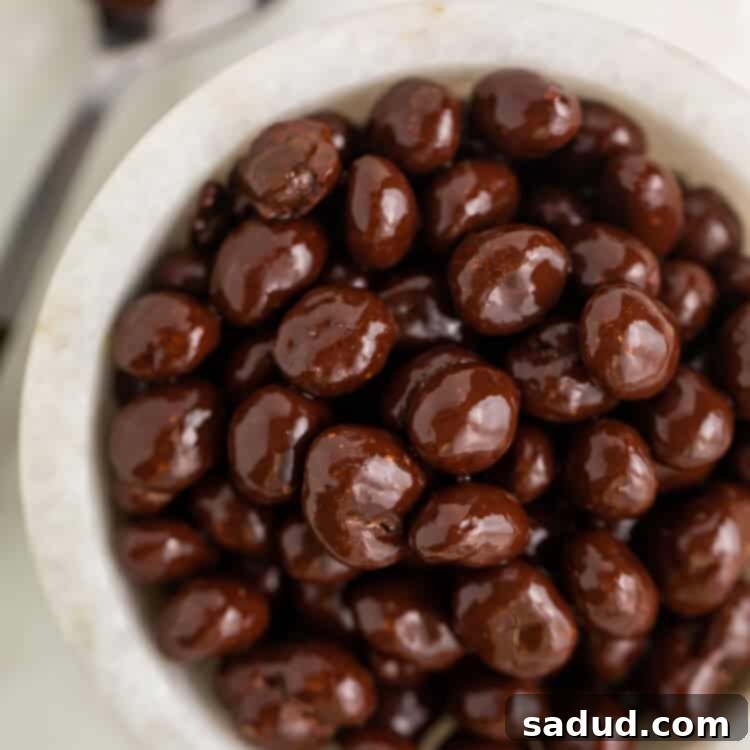
Chocolate Covered Espresso Beans
 Cheryl Malik
Cheryl Malik
Print
SaveSaved!
Ingredients
- 1 cup espresso beans
- 1 cup semi-sweet chocolate chips or 1 milk chocolate bar
Equipment
-
Microwave
-
Microwave-safe bowl
-
Baking sheet
-
Parchment paper
Instructions
-
Place chocolate chips (or chocolate bar, broken into pieces) in microwave-safe bowl.

-
Microwave in 10-second intervals, stirring between each, until chocolate is melted. Be careful not to burn chocolate.

-
Remove bowl from microwave and add in espresso beans, stirring until well combined.

-
Remove each espresso bean individually using a fork. Place beans on baking sheet lined with parchment paper, being careful not to let them touch.

-
Repeat until all beans are coated in chocolate and placed on parchment paper.

-
Let beans cool at room temperature. Alternately, chill them in the refrigerator to help them set up faster.
Notes
- Make it Keto: Use keto-friendly chocolates like Choczero or Lily’s brands chocolate.
Recipe yields approximately 8 servings. Nutritional values shown reflect information for 1 serving. Macros may vary slightly depending on the specific brands of ingredients used.
To determine the size of one serving, prepare the recipe as instructed, then weigh the entire finished recipe . Divide the total weight of the recipe (not including the weight of the bowl, pot, or plate the food is in) by 8. Result will be the weight of one serving.
Nutrition Information
Number of total servings shown is approximate. Actual number of servings will depend on your preferred portion sizes.
Nutritional values shown are general guidelines and reflect information for 1 serving using the ingredients listed, not including any optional ingredients. Actual macros may vary slightly depending on specific brands and types of ingredients used.
To determine the weight of one serving, prepare the recipe as instructed. Weigh the finished recipe, then divide the weight of the finished recipe (not including the weight of the container the food is in) by the desired number of servings. Result will be the weight of one serving.
